Development and Validation for Quantification of 7-Nitroso Impurity in Sitagliptin by Ultraperformance Liquid Chromatography with Triple Quadrupole Mass Spectrometry
Abstract
1. Introduction
2. Results and Discussions
2.1. Optimization of Mass Spectrometric Parameters
2.2. Optimization of Chromatographic Conditions
2.3. Method Validation Study
2.4. Specificity and System Suitability
2.5. LOD, LOQ and LOQ Precision
2.6. Linearity and Range
2.7. Method Precision
2.8. Intermediate Precision
2.9. Accuracy
2.10. Robustness
2.11. Solution Stability
3. Materials and Methods
3.1. Materials and Reagents
3.2. Equipment
3.3. Chromatographic Conditions
3.4. Mass Spectrometer Conditions
3.5. Preparation of Impurity Standard and Test Sample Solutions
4. Conclusions
Supplementary Materials
Author Contributions
Funding
Institutional Review Board Statement
Informed Consent Statement
Data Availability Statement
Acknowledgments
Conflicts of Interest
Sample Availability
References
- Szekely, G.; Amores de Sousa, M.C.; Gil, M.; Castelo Ferreira, F.; Heggie, W. Genotoxic impurities in pharmaceutical manufacturing: Sources, regulations, and mitigation. Chem. Rev. 2015, 115, 8182–8229. [Google Scholar] [CrossRef] [PubMed]
- Reddy, A.V.B.; Jaafar, J.; Umar, K.; Majid, Z.A.; Aris, A.B.; Talib, J.; Madhavi, G. Identification, control strategies, and analytical approaches for the determination of potential genotoxic impurities in pharmaceuticals: A comprehensive review. J. Sep. Sci. 2015, 38, 764–779. [Google Scholar] [CrossRef] [PubMed]
- Ahuja, S. Isolation and Characterization of Pharmaceutical Impurities Evaluation; Elsevier: New York, NY, USA, 2000. [Google Scholar]
- Wang, T.; Yang, H.; Yang, J.; Guo, N.; Wu, G.; Xu, X.; An, M. Quantitative Determination of Four Potential Genotoxic Impurities in the Active Pharmaceutical Ingredients in TSD-1 Using UPLC-MS/MS. Molecules 2022, 27, 4129. [Google Scholar] [CrossRef] [PubMed]
- Pokar, D.; Rajput, N.; Sengupta, P. Industrial approaches and consideration of clinical relevance in setting impurity level specification for drug substances and drug products. Int. J. Pharm. 2020, 576, 119018. [Google Scholar] [CrossRef] [PubMed]
- Zeller, A.; Brigo, A.; Brink, A.; Guerard, M.; Lang, D.; Muster, W.; Runge, F.; Sutter, A.; Vock, E.; Wichard, J. Genotoxicity assessment of drug metabolites in the context of MIST and beyond. Chem. Res. Toxicol. 2019, 33, 10–19. [Google Scholar] [CrossRef]
- Zhang, K.; Pellett, J.D.; Narang, A.S.; Wang, Y.J.; Zhang, Y.T. Reactive impurities in large and small molecule pharmaceutical excipients–A review. TrAC Trends Anal. Chem. 2018, 101, 34–42. [Google Scholar] [CrossRef]
- Guideline, I.H.T. Impurities in new drug substances Q3A (R2). In Proceedings of the International Conference on Harmonization of Technical Requirements for Registration of Pharmaceuticals for Human Use, Geneva, Switzerland, 25 October 2006. [Google Scholar]
- Guideline, I. Assessment and control of dna reactive (mutagenic) impurities in pharmaceuticals to limit potential carcinogenic risk M7. In Proceedings of the International Conference on Harmonization of Technical Requirements for Registration of Pharmaceuticals for Human Use (ICH), Geneva, Switzerland, 31 March 2017. [Google Scholar]
- Gao, H.; Yu, J.; Ge, C.; Jiang, Q. Practical asymmetric synthesis of sitagliptin phosphate monohydrate. Molecules 2018, 23, 1440. [Google Scholar] [CrossRef]
- US Food and Drug Administration label Januvia of Merck. Available online: https://www.accessdata.fda.gov/drugsatfda_docs/label/2012/021995s019lbl.pdf (accessed on 26 February 2012).
- Scott, L.J. Sitagliptin: A review in type 2 diabetes. Drugs 2017, 77, 209–224. [Google Scholar] [CrossRef]
- EMA/409815/2020; Rev.11 of Questions and Answers for Marketing Authorisation Holders/Applicants on the CHMP Opinion for the Article 5(3) of Regulation (EC) No 726/2004 Referral on Nitrosamine Impurities in Human Medicinal Products. European Medicines Agency: Amsterdam, The Netherlands, 2020.
- Schmidtsdorff, S.; Neumann, J.; Schmidt, A.H.; Parr, M.K. Risk assessment for nitrosated pharmaceuticals: A future perspective in drug development. Arch. Der Pharm. 2022, 355, 2100435. [Google Scholar] [CrossRef]
- Vuyyuru, N.R.; Krishna, G.V.; Ramadevi, B.; Kumar, Y.R. Evaluation of Process Impurities and Degradants of Sitagliptin Phosphate by Validated Stability Indicating RP-LC Method. Asian J. Chem. 2017, 29, 1941–1947. [Google Scholar] [CrossRef]
- Deepthi, V.; Poornima, Y.; Rao, G.D.; Reddy, T.S. Stability-indicating RPHPLC method for analysis of sitagliptin in the bulk drug and it’s pharmaceutical dosage form. Int. J. Pharm. Pharm. Sci. 2013, 5, 320–325. [Google Scholar]
- Jain, P.; Chaudhari, A.; Surana, S. Development and validation of stability-indicating high-performance thin-layer chromatography method for estimation of sitagliptin phosphate monohydrate in bulk and in pharmaceutical formulation. Acta Chromatogr. 2014, 26, 309–319. [Google Scholar] [CrossRef]
- Saleh, O.A.; El-Azzouny, A.A.E.-S.; Aboul-Enein, H.Y.; Badawey, A.M. A validated stability indicating HPLC method for determination of sitagliptin. Eur. J. Chem. 2014, 5, 497–502. [Google Scholar] [CrossRef][Green Version]
- Ramalingam, P.; Bhaskar, V.U.; Reddy, Y.P.; Kumar, K.V. Stability-indicating RP-HPLC method for the simultaneous determination of sitagliptin and simvastatin in tablets. Indian J. Pharm. Sci. 2014, 76, 407. [Google Scholar] [PubMed]
- Dalawai, M.V.; Sanasi, P.D.; Sharma, H.K. Development and Validation of Simple Effective Hplc Method for the Quantitative Determination of Related Substance Present in Sitagliptin Phosphate Drug Substance. Int. J. Pharm. Sci. Res. 2016, 7, 1493. [Google Scholar]
- Dalawai, M.V.; Sanasi, P.; Sharma, H. Development and validation of stability indicating assay method by HPLC for the analysis of sitagliptin phospahte in bulk drug substances. J. Chem. Pharm. Res. 2015, 7, 781–787. [Google Scholar]
- Kirkpatrick, D.; Fain, M.; Yang, J.; Trehy, M. Enantiomeric impurity analysis using circular dichroism spectroscopy with United States Pharmacopeia liquid chromatographic methods. J. Pharm. Biomed. Anal. 2018, 156, 366–371. [Google Scholar] [CrossRef]
- Gumieniczek, A.; Berecka, A.; Mroczek, T.; Wojtanowski, K.; Dąbrowska, K.; Stępień, K. Determination of chemical stability of sitagliptin by LC-UV, LC-MS and FT-IR methods. J. Pharm. Biomed. Anal. 2019, 164, 789–807. [Google Scholar] [CrossRef]
- Pathade, P. Stability indicating UV Spectrophotometric method has been developed for quantitative determination of Sitagliptin Phosphate in bulk and pharmaceutical formulations. J. Pharm. Res. 2011, 4, 871–873. [Google Scholar]
- Mowaka, S.; Mohamed, D. Novel contribution to the simultaneous analysis of certain hypoglycemic drugs in the presence of their impurities and degradation products utilizing UPLC-MS/MS. RSC Adv. 2015, 5, 60467–60481. [Google Scholar] [CrossRef]
- Guideline, I.H.T. Validation of Analytical Procedures: Text and Methodology. Q2 2005, 1, 5. [Google Scholar]
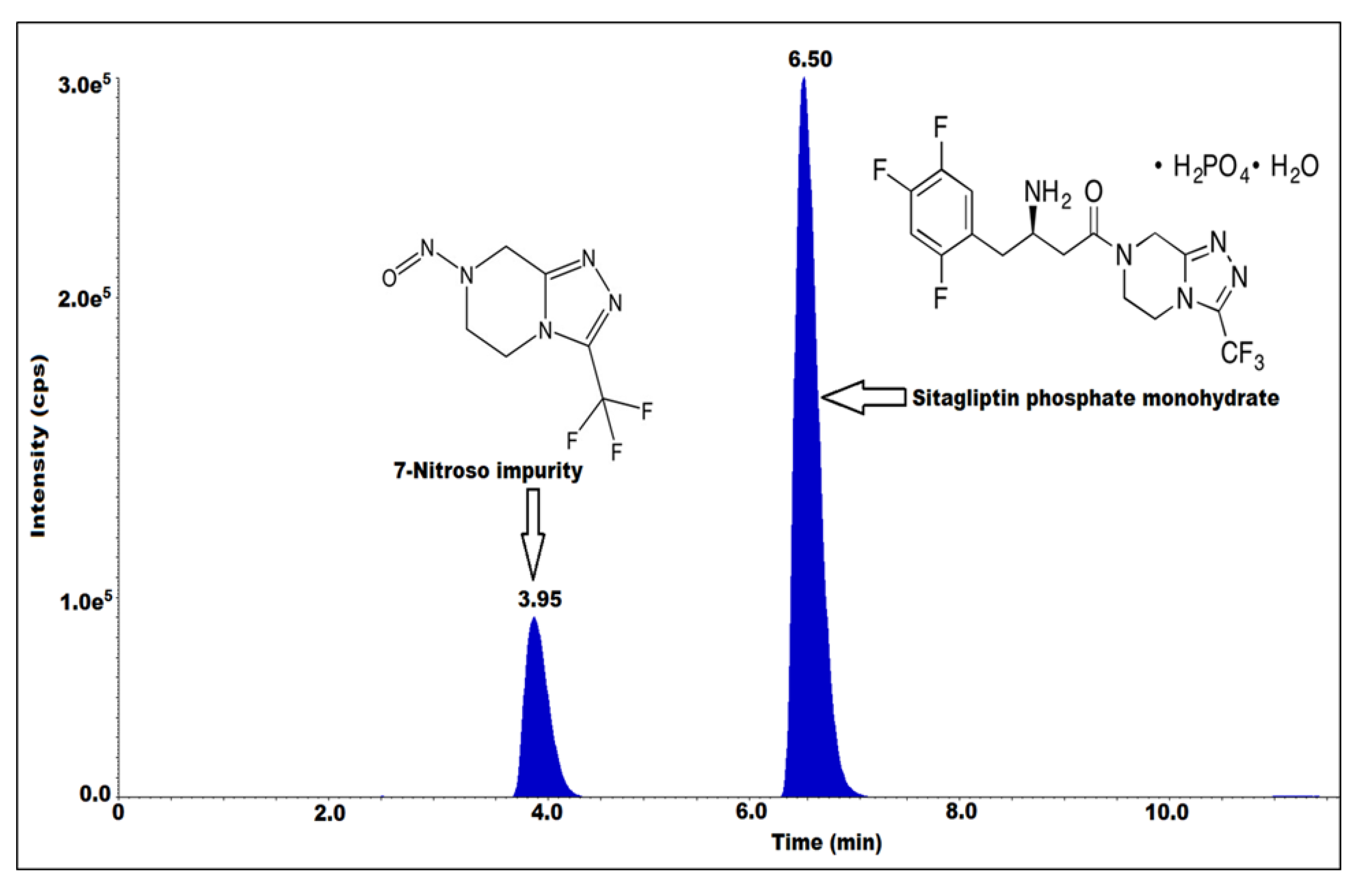
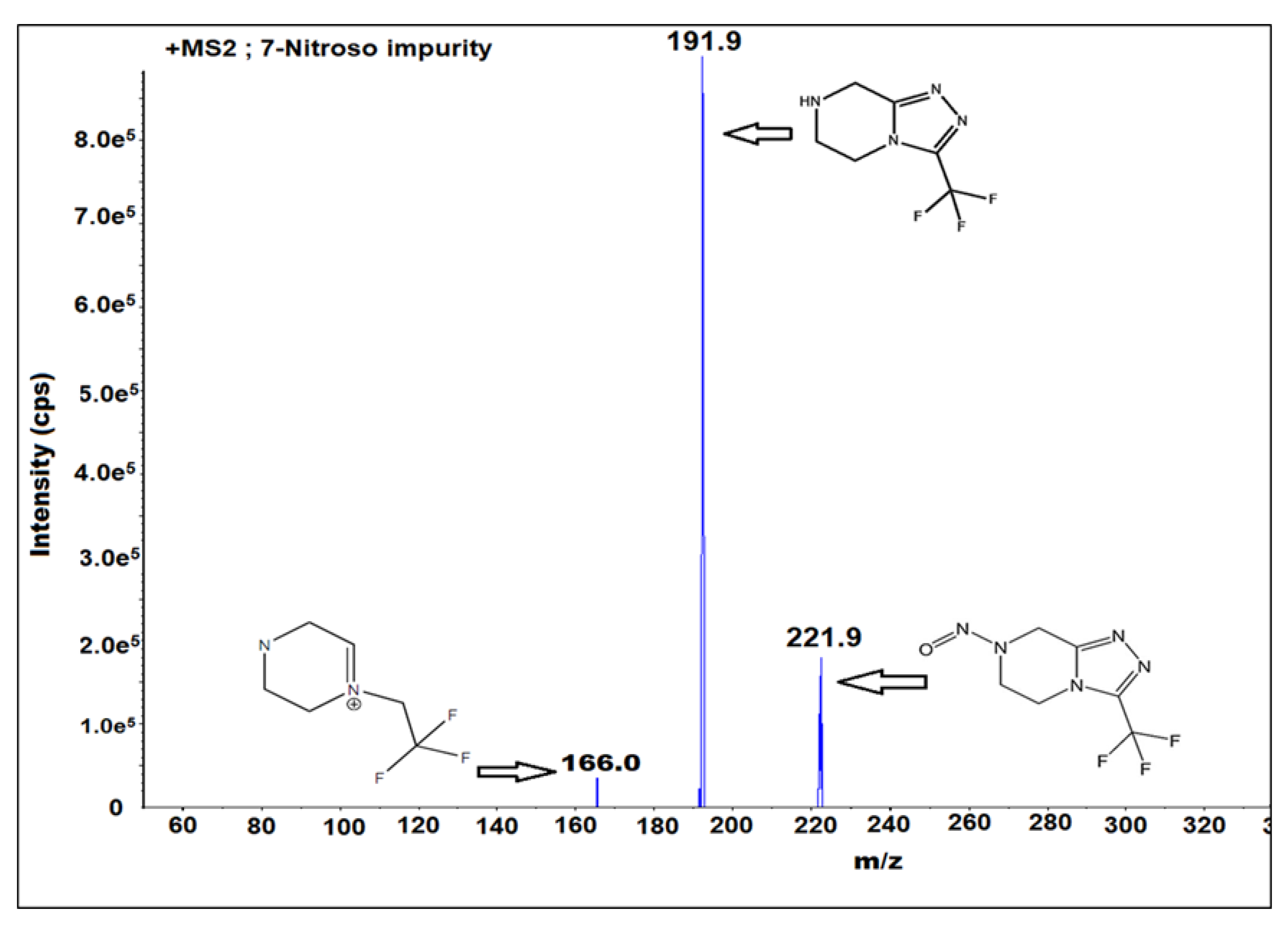
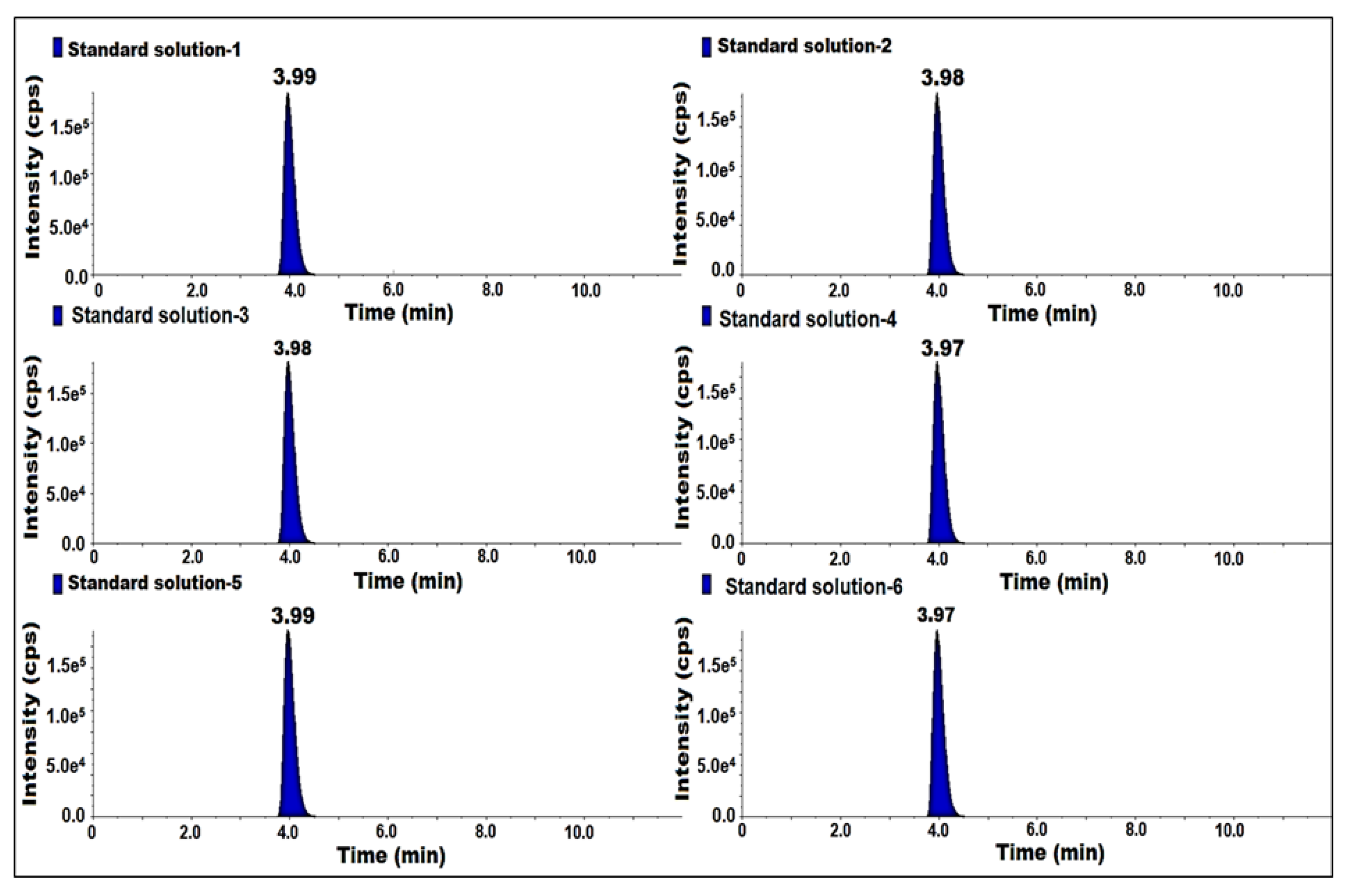
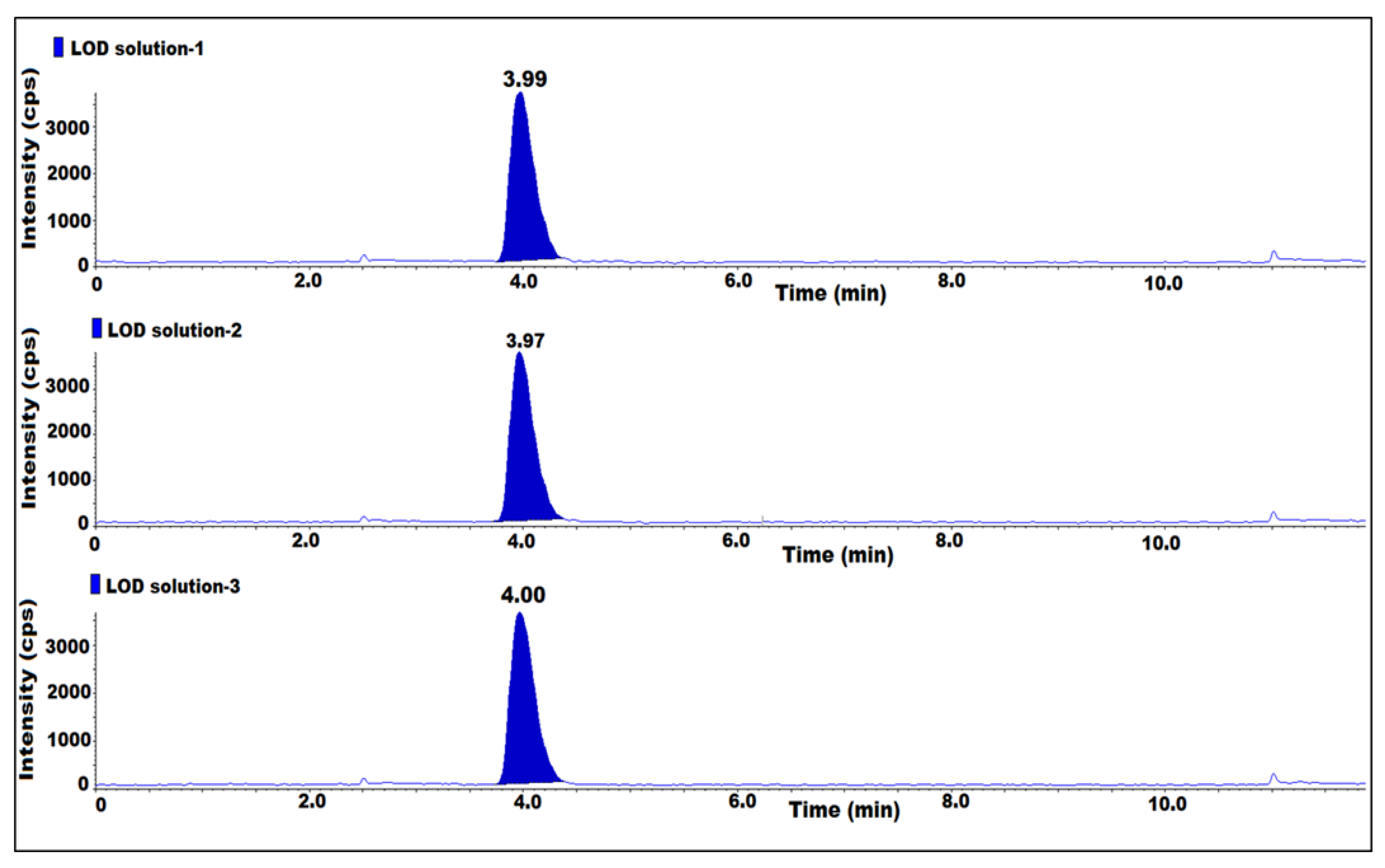
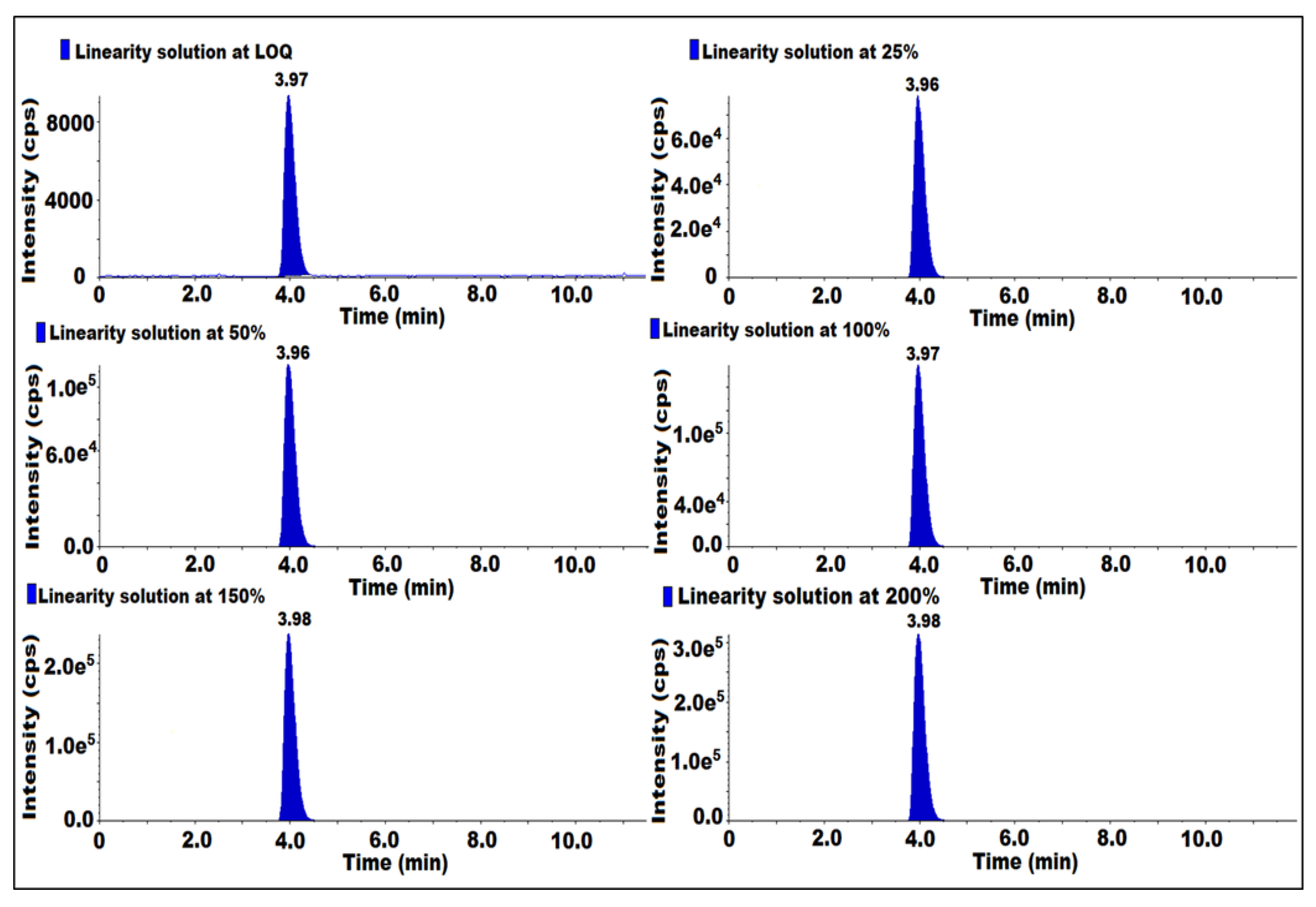

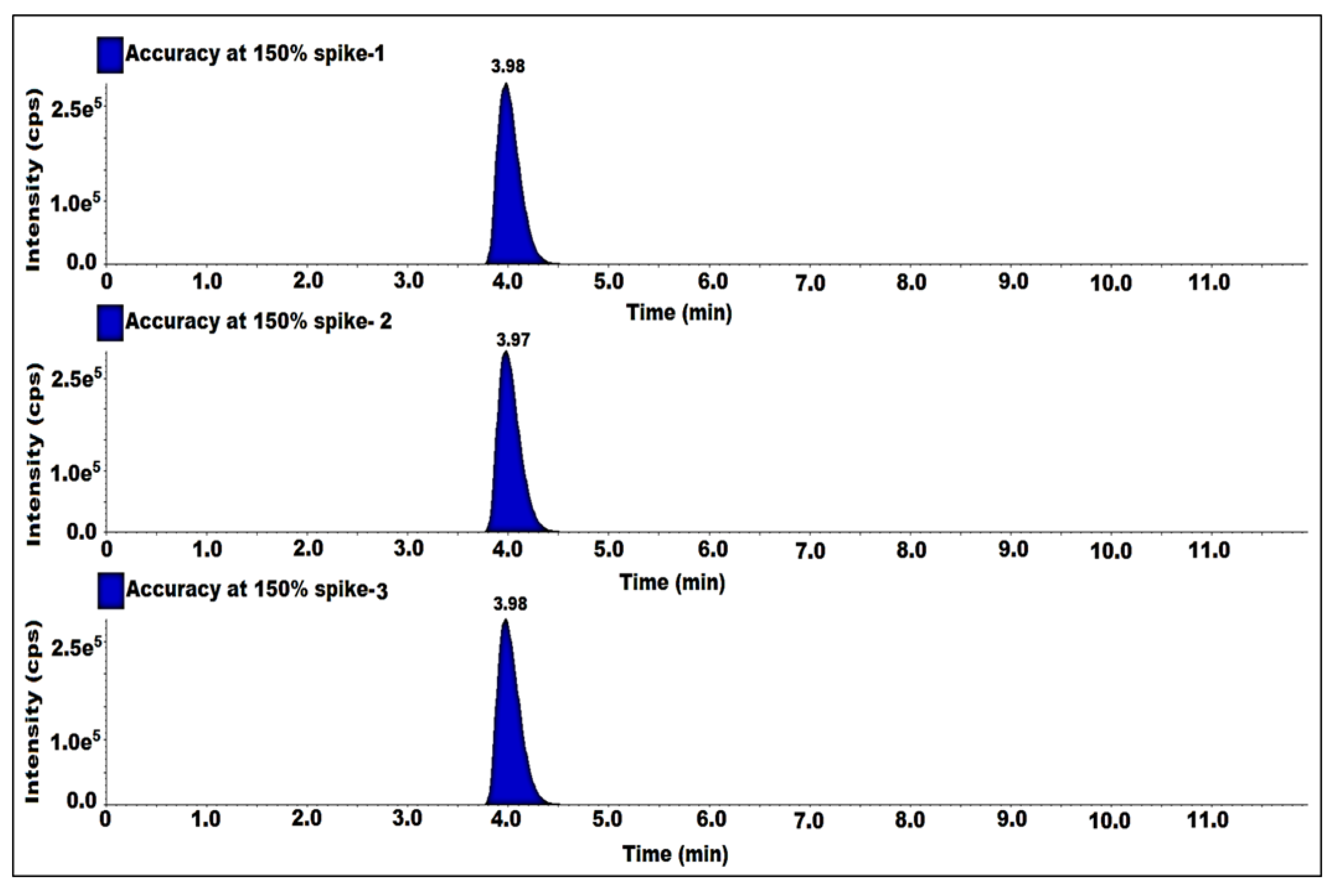
| Parameter | Condition |
|---|---|
| Liquid chromatography conditions | |
| Mobile phase A | 0.12% formic acid in water |
| Mobile phase B | 0.12% formic acid in Methanol |
| Auto-sampler temperature | 8 °C |
| Temperature of the column | 40 °C |
| Flow rate | 0.6 mL/min |
| Injection volume | 50 μL |
| Gradient program (time(min)/mobile phase A) | 0/75, 6/75, 6.1/5, 8/5, 8.1/75, 12/75 |
| Diluent | Water |
| Run time | 12 min |
| Mass spectrometry conditions | |
| Source and ionization mode | ESI-Positive |
| Detection mode | MRM |
| MRM (m/z) for quantification | 221.9 > 191.9 |
| Collision energy (CE) | 15 |
| De-clustering potential (DP) | 40 |
| Entrance potential (EP) | 10 |
| MS temperature | 400 °C |
| Validation Parameter | Typical Acceptance Criteria | Results |
|---|---|---|
| System suitability and Specificity | RSD (%) for 7-nitroso impurity peak area response (n = 6) should be ≤ 15.0. | 1.1% |
| RT of 7-nitroso impurity peak in all the solutions. | 4.0 min | |
| Interference from blank | No interference | |
| LOD | Concentration of LOD in ppm s/n value should be ≥3 | 0.002 ppm 11 |
| LOQ | Concentration of LOQ in ppm s/n value should be ≥10 | 0.005 ppm 33 |
| LOQ precision | RSD (%) for six replicate injections of LOQ solution should be ≤ 15.0% | 3.1% |
| Linearity | Range (ppm) Square of correlation coefficient (r2) ≥ 0.99 | 0.005 to 0.06 ppm 0.999 |
| Validation Parameter | Typical Acceptance Criteria | Results |
|---|---|---|
| Method precision | RSD (%) for six preparations (n = 6) of spiked sample at specification level should be ≤10.0 | 2.8% |
| Intermediate precision | RSD (%) for six preparations (n = 6) of spiked sample at specification level should be ≤10.0 | 3.2% |
| RSD (%) for preparations (n = 12) of MP and IP spiked sample at specification level should be ≤20.0 | Less than 20.0% | |
| Accuracy | LOQ average recovery (n = 3) should be between 70 to 130%. | 92.1% |
| 50% average recovery (n = 3) should be between 80 to 120%. | 89.6% | |
| 100% average recovery (n = 3) should be between 80 to 120%. | 95.2% | |
| 150% average recovery (n = 3) should be between 80 to 120%. | 97.3% | |
| Robustness | Plus (+) flow 0.7 mL/min: spiked sample concentration % difference and retention time | 2.3% 3.7 min |
| Minus (−) flow 0.5 mL/min: spiked sample concentration % difference and retention time | 2.5% 4.1 min | |
| Plus (+) oven 42 °C: spiked sample concentration % difference and retention time | 2.1% 3.8 min | |
| Minus (−) oven 38 °C: spiked sample concentration % difference and retention time | 2.7% 4.0 min | |
| Solution Stability | Standard and 100% spiked solution stored at ambient laboratory conditions (25 ± 5 °C) and refrigerated conditions (2–8 °C) were studied for 48 h | Solutions are Stable for 48 h |
Publisher’s Note: MDPI stays neutral with regard to jurisdictional claims in published maps and institutional affiliations. |
© 2022 by the authors. Licensee MDPI, Basel, Switzerland. This article is an open access article distributed under the terms and conditions of the Creative Commons Attribution (CC BY) license (https://creativecommons.org/licenses/by/4.0/).
Share and Cite
Chittireddy, H.N.P.R.; Kumar, J.V.S.; Bhimireddy, A.; Shaik, M.R.; Khan, M.; Adil, S.F.; Khan, M.; Aldhuwayhi, F.N. Development and Validation for Quantification of 7-Nitroso Impurity in Sitagliptin by Ultraperformance Liquid Chromatography with Triple Quadrupole Mass Spectrometry. Molecules 2022, 27, 8581. https://doi.org/10.3390/molecules27238581
Chittireddy HNPR, Kumar JVS, Bhimireddy A, Shaik MR, Khan M, Adil SF, Khan M, Aldhuwayhi FN. Development and Validation for Quantification of 7-Nitroso Impurity in Sitagliptin by Ultraperformance Liquid Chromatography with Triple Quadrupole Mass Spectrometry. Molecules. 2022; 27(23):8581. https://doi.org/10.3390/molecules27238581
Chicago/Turabian StyleChittireddy, Hari Naga Prasada Reddy, J. V. Shanmukha Kumar, Anuradha Bhimireddy, Mohammed Rafi Shaik, Merajuddin Khan, Syed Farooq Adil, Mujeeb Khan, and Fatimah N. Aldhuwayhi. 2022. "Development and Validation for Quantification of 7-Nitroso Impurity in Sitagliptin by Ultraperformance Liquid Chromatography with Triple Quadrupole Mass Spectrometry" Molecules 27, no. 23: 8581. https://doi.org/10.3390/molecules27238581
APA StyleChittireddy, H. N. P. R., Kumar, J. V. S., Bhimireddy, A., Shaik, M. R., Khan, M., Adil, S. F., Khan, M., & Aldhuwayhi, F. N. (2022). Development and Validation for Quantification of 7-Nitroso Impurity in Sitagliptin by Ultraperformance Liquid Chromatography with Triple Quadrupole Mass Spectrometry. Molecules, 27(23), 8581. https://doi.org/10.3390/molecules27238581











